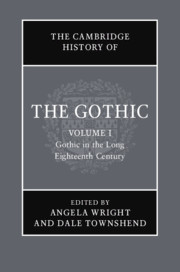Book contents
- The Cambridge History of the Gothic
- The Cambridge History of the Gothic
- The Cambridge History of the Gothic
- Copyright page
- Contents
- Illustrations and Captions for Volume I
- Notes on Contributors
- Acknowledgements
- Introduction: The Gothic in/and History
- 1.1 The Goths in Ancient History
- 1.2 The Term ‘Gothic’ in the Long Eighteenth Century, 1680‒1800
- 1.3 The Literary Gothic Before Horace Walpole’s The Castle of Otranto
- 1.4 Gothic Revival Architecture Before Horace Walpole’s Strawberry Hill
- 1.5 Horace Walpole and the Gothic
- 1.6 Shakespeare’s Gothic Transmigrations
- 1.7 Reassessing the Gothic/Classical Relationship
- 1.8 ‘A World of Bad Spirits’: The Terrors of Eighteenth-Century Empire
- 1.9 In Their Blood: The Eighteenth-Century Gothic Stage
- 1.10 Domestic Gothic Writing after Horace Walpole and before Ann Radcliffe
- 1.11 Early British Gothic and the American Revolution
- 1.12 Gothic and the French Revolution, 1789–1804
- 1.13 The Aesthetics of Terror and Horror: A Genealogy
- 1.14 Ann Radcliffe and Matthew Lewis
- 1.15 The Gothic Novel Beyond Radcliffe and Lewis
- 1.16 Oriental Gothic: Imperial-Commercial Nightmares from the Eighteenth Century to the Romantic Period
- 1.17 The German ‘School’ of Horrors: A Pharmacology of the Gothic
- 1.18 Gothic and the History of Sexuality
- 1.19 Gothic Art and Gothic Culture in the Romantic Era
- 1.20 Time in the Gothic
- Select Bibliography
- Index
1.5 - Horace Walpole and the Gothic
Published online by Cambridge University Press: 16 July 2020
- The Cambridge History of the Gothic
- The Cambridge History of the Gothic
- The Cambridge History of the Gothic
- Copyright page
- Contents
- Illustrations and Captions for Volume I
- Notes on Contributors
- Acknowledgements
- Introduction: The Gothic in/and History
- 1.1 The Goths in Ancient History
- 1.2 The Term ‘Gothic’ in the Long Eighteenth Century, 1680‒1800
- 1.3 The Literary Gothic Before Horace Walpole’s The Castle of Otranto
- 1.4 Gothic Revival Architecture Before Horace Walpole’s Strawberry Hill
- 1.5 Horace Walpole and the Gothic
- 1.6 Shakespeare’s Gothic Transmigrations
- 1.7 Reassessing the Gothic/Classical Relationship
- 1.8 ‘A World of Bad Spirits’: The Terrors of Eighteenth-Century Empire
- 1.9 In Their Blood: The Eighteenth-Century Gothic Stage
- 1.10 Domestic Gothic Writing after Horace Walpole and before Ann Radcliffe
- 1.11 Early British Gothic and the American Revolution
- 1.12 Gothic and the French Revolution, 1789–1804
- 1.13 The Aesthetics of Terror and Horror: A Genealogy
- 1.14 Ann Radcliffe and Matthew Lewis
- 1.15 The Gothic Novel Beyond Radcliffe and Lewis
- 1.16 Oriental Gothic: Imperial-Commercial Nightmares from the Eighteenth Century to the Romantic Period
- 1.17 The German ‘School’ of Horrors: A Pharmacology of the Gothic
- 1.18 Gothic and the History of Sexuality
- 1.19 Gothic Art and Gothic Culture in the Romantic Era
- 1.20 Time in the Gothic
- Select Bibliography
- Index
Summary
Horace Walpole is pivotal to the early Gothic Revival as the author of what has long been hailed as the first Gothic novel, and as the creator of the most influential of all early Gothic Revival houses. This essay explores his intuitively imaginative response to Gothic, and how his love of the decorative profusion and allusive richness that it could offer was played out in his novel The Castle of Otranto (1765) and his play The Mysterious Mother (1768) – as well as in in his ‘castle’ at Strawberry Hill. That house, with its subtle management of scale, colour and light, and in the suggestive riches of the collection it contained, created a heady mixture of fantasy and atmosphere, displaying an historically informed but archaeologically unrestrained imagination. These are qualities that it shared with Walpole’s Gothic fictions. There is hardly a feature of Gothic romance that does not appear in Otranto, and its gloomy castle, predatory patriarch and pursued virgin, along with the guilt-tormented Countess and evil friars of The Mysterious Mother, like the Gothic battlements and evocative interiors of Strawberry Hill, engendered a lasting and pervasive progeny.
- Type
- Chapter
- Information
- The Cambridge History of the GothicVolume 1: Gothic in the Long Eighteenth Century, pp. 120 - 140Publisher: Cambridge University PressPrint publication year: 2020

